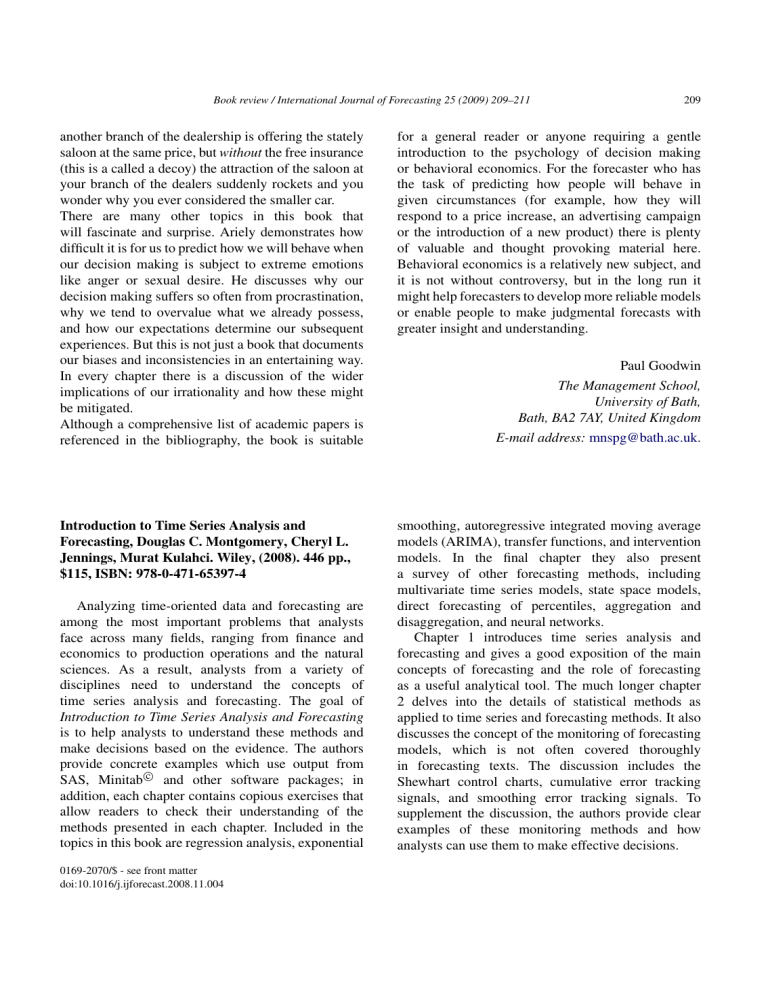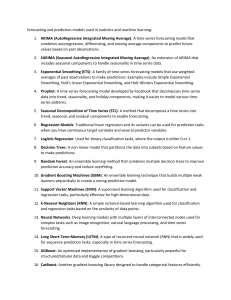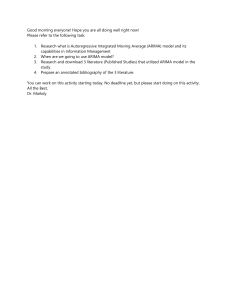
Book review / International Journal of Forecasting 25 (2009) 209–211 209 another branch of the dealership is offering the stately saloon at the same price, but without the free insurance (this is a called a decoy) the attraction of the saloon at your branch of the dealers suddenly rockets and you wonder why you ever considered the smaller car. There are many other topics in this book that will fascinate and surprise. Ariely demonstrates how difficult it is for us to predict how we will behave when our decision making is subject to extreme emotions like anger or sexual desire. He discusses why our decision making suffers so often from procrastination, why we tend to overvalue what we already possess, and how our expectations determine our subsequent experiences. But this is not just a book that documents our biases and inconsistencies in an entertaining way. In every chapter there is a discussion of the wider implications of our irrationality and how these might be mitigated. Although a comprehensive list of academic papers is referenced in the bibliography, the book is suitable for a general reader or anyone requiring a gentle introduction to the psychology of decision making or behavioral economics. For the forecaster who has the task of predicting how people will behave in given circumstances (for example, how they will respond to a price increase, an advertising campaign or the introduction of a new product) there is plenty of valuable and thought provoking material here. Behavioral economics is a relatively new subject, and it is not without controversy, but in the long run it might help forecasters to develop more reliable models or enable people to make judgmental forecasts with greater insight and understanding. Introduction to Time Series Analysis and Forecasting, Douglas C. Montgomery, Cheryl L. Jennings, Murat Kulahci. Wiley, (2008). 446 pp., $115, ISBN: 978-0-471-65397-4 smoothing, autoregressive integrated moving average models (ARIMA), transfer functions, and intervention models. In the final chapter they also present a survey of other forecasting methods, including multivariate time series models, state space models, direct forecasting of percentiles, aggregation and disaggregation, and neural networks. Chapter 1 introduces time series analysis and forecasting and gives a good exposition of the main concepts of forecasting and the role of forecasting as a useful analytical tool. The much longer chapter 2 delves into the details of statistical methods as applied to time series and forecasting methods. It also discusses the concept of the monitoring of forecasting models, which is not often covered thoroughly in forecasting texts. The discussion includes the Shewhart control charts, cumulative error tracking signals, and smoothing error tracking signals. To supplement the discussion, the authors provide clear examples of these monitoring methods and how analysts can use them to make effective decisions. Analyzing time-oriented data and forecasting are among the most important problems that analysts face across many fields, ranging from finance and economics to production operations and the natural sciences. As a result, analysts from a variety of disciplines need to understand the concepts of time series analysis and forecasting. The goal of Introduction to Time Series Analysis and Forecasting is to help analysts to understand these methods and make decisions based on the evidence. The authors provide concrete examples which use output from SAS, Minitab c and other software packages; in addition, each chapter contains copious exercises that allow readers to check their understanding of the methods presented in each chapter. Included in the topics in this book are regression analysis, exponential 0169-2070/$ - see front matter doi:10.1016/j.ijforecast.2008.11.004 Paul Goodwin The Management School, University of Bath, Bath, BA2 7AY, United Kingdom E-mail address: mnspg@bath.ac.uk. 210 Book review / International Journal of Forecasting 25 (2009) 209–211 Chapter 3 posits the concept of regression analysis, since the heart of many of these time series and forecasting methods is regression analysis using calculus and matrix algebra. The calculus is used to derive the OLS estimators used in regression, while matrix algebra is used to compute them. The authors make good use of Minitab c to illustrate the regression output and to show how these estimates were derived. The derivations will be useful, for this enhances the comprehension of regression analysis. The authors acknowledge that regression analysis for time series data has some problems (e.g., autocorrelation). They provide a generalized least squares (GLS) framework as a remedy for the problem of autocorrelation in time series. They also discuss discounted least squares, unlike most other introductory books. In OLS, the older observations receive the same weight as recent observations. However, the recent observations may be more important for the true behavior of the time series process; therefore, the use of the discounted least squares method allows older observations to receive less weight than more recent observations. The final part of the chapter presents regression methods as they are applied to time series and forecasting methods. This discussion covers the standard material on autocorrelation and the Durbin–Watson test statistic, as well as methods for correcting for autocorrelation, such as Cochrane–Orcutt and maximum likelihood estimators (MLE). This discussion is enhanced with copious examples of SAS output, namely using the procedure PROC AUTOREG. Chapter 4 provides the standard discussion on exponential smoothing methods, with the first part presenting the moving average method, then shifting to exponential smoothing methods. The final discussion of exponential smoothing as applied to seasonality is useful to analysts, since much of the work with time series involves the issue of seasonality. Chapter 5 introduces the autoregressive integrated moving average (ARIMA) models, known as the Box– Jenkins approach. The first part of the chapter provides separate discussions of the moving average and autoregressive processes, followed by PACF and ACF, which are used extensively in ARIMA modeling. This material is followed by a discussion of ARMA and ARIMA models. A comprehensive discussion ensues about how the analyst can use ACFs and PACFs in the determination of the AR and MA processes, as well as ARMA. The development of ARIMA models is often not straightforward, and the authors present the standard approach to ARIMA model building: model identification, parameter estimation, and diagnostic checking. This discussion is supplemented with actual data, with output from Minitab c . These concrete examples provide a greater understanding of how these models are developed. The final section of the chapter uses these ARIMA models in forecasting. Chapter 6 introduces transfer function and intervention models. The authors make it clear that the development of the transfer functions is more arduous than the development of the ARIMA models. Intervention analysis examines the impacts of a known event (e.g., a change in the regulatory procedure or a catastrophic event), and represents a qualitative change in state. Then the analyst would want to know the nature and magnitudes of the impacts of these interventions on the time series models and forecasts. The authors discuss how to develop these intervention models and how to interpret their results. The final chapter is a smorgasbord of topics pertaining to time series and forecasting, including multivariate time series models: vector autoregressive models, autoregressive conditional heteroscedasticity (ARCH) and generalized autoregressive conditional heteroscedasticity (GARCH) models, state space models, direct forecasting of percentiles, aggregation and disaggregation, and neural networks. These are only introduced, and someone wanting more comprehensive information about these time series and forecasting methods would need to read supplementary materials in order to learn the details of these methods. Some of the early chapters are lengthy and include details about methods, but these details are essential if one wishes to develop a good, comprehensive understanding of these analytical methods. The discussion of ARIMA modeling in chapter 5 is thorough, but the authors might have stressed that the use of ARIMA in short-term forecasting is appropriate, but that longer term forecasts tend to be overstated. The final chapter is a brief overview of other time series and forecasting methods, but a reader might be better served if some of these methods were covered in greater detail. A relevant topic for a chapter might have been structural time series models, which would have provided a nice complement to the ARIMA models. Structural time series models Book review / International Journal of Forecasting 25 (2009) 209–211 look at the unobserved components, such as trend, seasonality, cyclical and irregular components, and the analyst can develop forecasts based on these models. Brian W. Sloboda was formerly an economist at the Bureau of Transportation Statistics in the US Department of Transportation, and at the Bureau of Economic Analysis in the US Department of Commerce. Currently, he is a pricing economist at the US Postal Service. He is also teaching economics and 211 statistics for the University of Phoenix, University of Maryland, Park University, and the USDA Graduate School. He has written numerous articles on the topics of regional economics, transportation economics, and labor economics. Brian Sloboda 8750 Georgia Ave, 112B, Silver Spring, MD, 20910, United States E-mail address: bsloboda@email.phoenix.edu.







